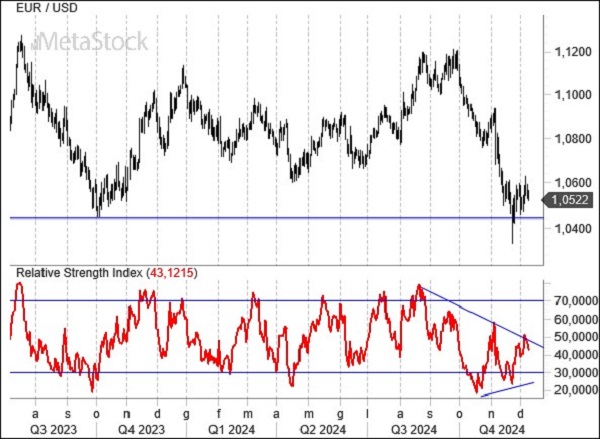- Inflation in the U.S. rises for the second consecutive month, making a 25 basis point cut by the Federal Reserve almost certain, followed by an extended pause as they assess the economic impact.
- With France and Germany grappling with a severe political crisis, the ECB reduces interest rates by 25 basis points as expected but eases pressure on the euro.
- EUR/USD remains near key support levels at 1.05, suggesting only a modest rebound for now.
U.S. Inflation, ECB Rate Cuts, and European Political Uncertainty Drive Market Dynamics
For the second consecutive month, U.S. inflation has increased. With a 2.7% rise in consumer prices recorded in November (following October’s 2.6%), the deflationary effect from energy prices has been offset by inflationary pressures from food, housing, and transportation. Core inflation remains above 3% (at 3.3%), a crucial indicator ahead of the Federal Reserve’s year-end meeting. A 25 basis point rate cut is expected, but a prolonged pause in monetary policy adjustments seems likely through the first half of 2025.
This explains the persistence of yields on U.S. Treasuries staying above 4% for long-term maturities, as well as the strength of the U.S. dollar, which has not weakened after significant gains in recent weeks.
Meanwhile, in Europe, France continues to put pressure on the euro, while the ECB follows through with the widely anticipated 25 basis point rate cut. The market expects at least another 125 basis points in rate reductions over the next 12 months.
Macroeconomic data has been sparse in recent weeks, but the yield spreads between Paris and the rest of Europe remain under pressure. In terms of rate differentials with Germany, the market is already factoring in a worsening creditworthiness outlook for France, foreshadowing potential downgrades from rating agencies unless a political solution to the crisis is found soon. We will see if the new government appointed by Macron will succeed.
The crisis also persists in Germany, with early elections expected by the end of February, adding yet another uncertainty for a continent already dealing with border wars and significant socio-economic changes.
Returning to the ECB’s decision, the reduction in the cost of money will not be the last, as Frankfurt is confident that core inflation will fall back below 2% by 2026. The statement accompanying the decision omitted any commitment to maintaining a sufficiently restrictive monetary policy, which was enough for markets to sense the possibility of further cuts.
Technical Analysis: EUR/USD Struggles at Key Support as Resistance Holds Strong
For now, EUR/USD hovers around 1.05. As previously mentioned, this level is crucial for the future of the world’s most traded currency pair, and this can be understood from the many failed attempts in recent years to break below it.
RSI oscillators, for example, showed divergence in oversold territory, signaling the potential for a rebound, which did materialize. The problem for the euro is that the same indicator failed to break through the initial resistance levels. This leaves little hope for a more vigorous reaction from the euro at this point.
EUR/USD (Daily Chart) – Unconvincing Divergence Between Price and Oscillators
As we approach the Federal Reserve’s meeting, it’s impossible to overlook the tight correlation between the strength of the U.S. dollar and the weakness of the bond market, indicating rising interest rates, especially at the longer end of the yield curve.
The consolidation of the yield on 10-year U.S. Treasury Notes above 4% has allowed the Dollar Index to solidify recent gains, and it’s unlikely that we will see a reversal in the greenback’s strength unless there is a similar maneuver on rates.


Leave a Reply
You must be logged in to post a comment.